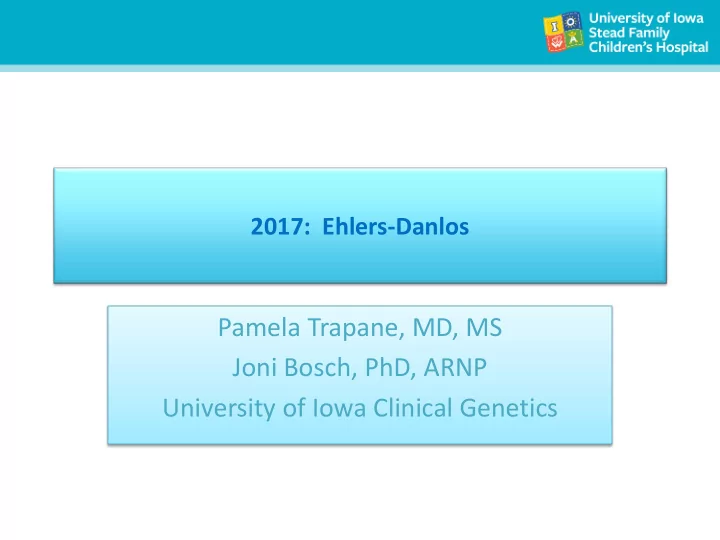

2017: Ehlers-Danlos Pamela Trapane, MD, MS Joni Bosch, PhD, ARNP University of Iowa Clinical Genetics
• In March 2017, EDS researchers around the world published new standards and guidelines for EDS and related disorders in the American Journal of Medical Genetics
• First mentioned by Hippocrates 4 th century BCE • Elastic Skin Man • India Rubber Man • Human Pretzel • 1930 “Ehlers - Danlos”
But Why??? • 1986 Berlin Meeting – 11 subtypes – Roman numbers • 1998 Villefranche – 6 subtypes – Descriptions • 2012 Ghent – Research/Registries – Keep up with changes
Biggest changes • Changes in names • Need genetic testing to confirm any diagnosis other than hEDS • Hypermobility EDS now either hEDS or Joint Hypermobility Spectrum Disorder
Rarer types of EDS will require genetic testing • Classical • Brittle cornea syndrome – BCS SNF469/PRDM5 cEDS Col1A1 • Classical-like • Spondylodysplastic – clEDS Tenascin-x – spEDS B4GALT7 – spEDS B3GALT6 • Cardiovalvular – spEDS SLC39A13 – cvEDS COL1A2 • Musculocontractural • Arthrochalasia EDS – mcEDS – aEDS COL1A1/COL1A2 D4ST1/CHST14/DSE • Dermatosparaxis • Myopathic – dEDS ADAMTS2 – mEDS COL12A1 • Kyphoscoliotic • Periodontal – K EDS PLOD1/FKBP14 – pEDS COL3A1/C1R/C1S
NOT TO PANIC! • Many people with EDS hypermobility form would not currently meet criteria for hEDS • If you have hypermobility EDS you do NOT have to be rediagnosed! • hEDS is NOT better or worse than “Joint Hypermobility Spectrum Disorder” • Problems and treatments are the same • May have different diagnoses in same family
Diagnosis hEDS • Have to meet 3 criterion – Generalized joint hypermobility – Systemic problems • Must have at least 2 of 3 – Must not have evidence of another connective tissue problem • Go to EDS website!
Criterion 1: Hypermobility • Generalized joint hypermobility – >= 6 preteen – >=5 Teens to 49 – >=4 older than 50 • History 1 extra point – Can you know or could you ever touch both palms to floor – Ever touch thumb to forearm – Do Splits or joint tricks – Dislocate knee or shoulder more than once as a child or teen – Do you consider yourself double jointed
Criterion 2 SYSTEMIC, Family History & Musculoskeletal • Must have at least 2 of criterion 2 A Systemic A, B and C 1. soft skin • 5 of 12 of feature A 2. mild skin stretchiness 3. odd stretch marks 4. piezogenic papules both heels 5. recurrent or several hernias 6. atrophic scarring at least 2 places 7. pelvic floor prolapse without a pregnancy 8. Dental crowding or high palate 9. arachnodactyly 10. armspan/ht >=1.05 11. >=mild mitral prolapse 12. aortic root dilation z>+2
Criterion 2 Systemic, FAMILY HISTORY &Musculoskeletal • B Family History – 1 st degree relatives • Parent, child, sib – Under new diagnostic criteria
Criterion 2 Systemic, Family History & MUSCULOSKELETAL • Pain in 2 or more limbs • Must have at least 1 at least 3 months • Chronic widespread pain at least 3 months • Recurrent dislocation or major instability – >=3 dislocations same joint – Or >=2 dislocations different joints – Medical confirmation joint instability
Criterion 3 “NOT THIS…” All must be met • Unusual skin fragility – Signs of other EDS • Other medical problem – Rheum – Marfan • Other joint/NM problem – Low muscle tone – Neuromuscular – Osteogenesis imperfecta
Summary • The changes are • Don’t need to do basically in words echoes as often for hEDS • One diagnosis is not – One normal as child better or worse than and one as adult the other • Best treatment • You do not need to be – Exercise Re-diagnosed – Drink more fluids – Eat more salt – Cognitive therapy
Questions
Recommend
More recommend